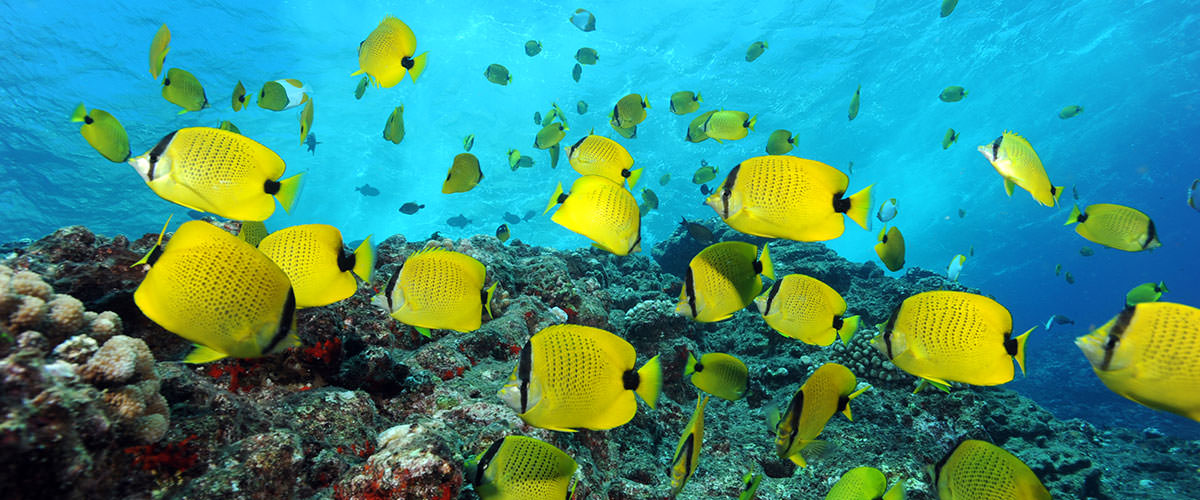
Click on individual links below to learn more about the immediate science needs for critical management issues. For a full list of management issues and science needs, please review the PMNM Management Plan. To contact us about the science needs described below, contact the Sanctuary Research Coordinators.
-
Alien Species
An alien or non-indigenous species can be defined as an organism that is not native to a particular ecosystem. In some cases, such alien species may become invasive by demonstrating rapid growth and spread, invading habitats and thereby displacing native organisms. Managers need to understand the potential ecological impacts of alien species to the natural resources of the Papahānaumokuākea Marine National Monument. (Updated September 2014)
-
Biodiversity
Managers require adequate information on the status of biodiversity in order to effectively protect resources of the Papahānaumokuākea Marine National Monument. (Updated September 2014)
-
Climate Change - Ocean Acidification
Global climate change is linked to increasing amounts of carbon dioxide in the atmosphere. This affects the chemical makeup of seawater resulting in ocean acidification, which can cause detrimental effects on calcifying marine organisms such as corals and coralline algae, thereby threatening the extensive reef habitats of the Papahānaumokuākea Marine National Monument. (Updated September 2014)
-
Climate Change - Sea Level Rise
Global climate change is documented to cause rises in sea levels. The impacts of sea-level rise in the Papahānaumokuā Marine National Monument (PMNM or Monument) include loss of terrestrial habitats and shallow-water marine habitats. (Updated September 2014)
-
Contaminants
Prior human activities in the Northwestern Hawaiian Islands (NWHI) have resulted in a variety of contaminants that remain in and around the islands. Managers need to understand the extent and impacts of these land-based sources of contamination to the marine resources of the Papahānaumokuā Marine National Monument. (Updated September 2014)
-
Coral Disease and Bleaching
The incidence of coral diseases and coral bleaching in the Papahānaumokuā Marine National Monument is currently low compared with reefs in other areas of the world. However, the possibility of new or increased levels of diseases or bleaching events, in combination with other threats to the health of Monument coral reefs, could be significant. (Updated September 2014)
-
Deep-Water Research
The vast majority of the Papahānaumokuākea Marine National Monument (PMNM or Monument) encompasses habitats beyond depths accessible through conventional SCUBA diving (>130 feet). Relatively little is known about such deep-water habitats or the organisms that inhabit them, despite the large area of the Monument that they represent. More information is necessary to establish baselines on the deep-water resources of the Monument in order to effectively manage and protect them. (Updated September 2014)
-
Endangered Species - The Hawaiian Monk Seal
The Hawaiian monk seal (Monachus schauinslandi) is in crisis, with current populations declining at a rate of 5% per year. This decline has lasted twenty years and only about 1200 monk seals remain. Information is needed to guide management efforts to recover this vulnerable species. (Updated September 2014)
-
Mapping of Resources
Managers require an understanding of the spatial distribution of biological, physical and cultural resources of the Papahānaumokuākea Marine National Monument in order to effectively target areas for management actions. (Updated September 2014)
-
Historical Ecology
Historical ecology involves the connection between people and the environment in which they live. Rather than examining one point in time, historical ecology may involve the human relationship to the environment over time in order to develop a broad understanding of this association. Humans have had an impact upon the marine environment in a variety of ways including extraction, harvesting, marine debris, invasive species and vessel groundings. The purpose of historical ecology in the context of management is to develop a better understanding of the baseline from which resources can be managed. (Updated September 2014)
-
Marine Debris
Many reefs in the Papahānaumokuākea Marine National Monument are inundated with marine debris originating from commercial fishing operations in the North Pacific or other marine or terrestrial sources. These objects degrade reef health by abrading, poisoning, smothering and dislodging corals and other benthic organisms, and entangling fish, marine mammals, crustaceans and other mobile species. Effective management requires a better understanding of the extent and impacts of this threat on the natural and historical resources of the Monument. (Updated September 2014)
-
Maritime Heritage
Maritime heritage resources have not been thoroughly inventoried in the Papahānaumokuākea Marine National Monument. Until relatively recently, many maritime heritage sites in the Northwestern Hawaiian Islands remained uninvestigated because of their remote location and the challenges of conducting work in these remote atolls. With the support of several partners, NOAA is leading the important process of identifying, documenting and protecting these maritime heritage resources in the Monument. The main Hawaiian Islands have experienced the illegal removal of historic artifacts, as well as the potential destruction of historic material from nearshore construction and dredging projects. By comparison, the NWHI maritime heritage resources are relatively intact and undisturbed. NOAA, the State of Hawaiʻi, and FWS have the statutory responsibility to inventory, evaluate, and interpret these heritage resources, and together increase maritime heritage preservation in the Monument and awareness of these unique resources throughout the State. (Updated September 2014)

